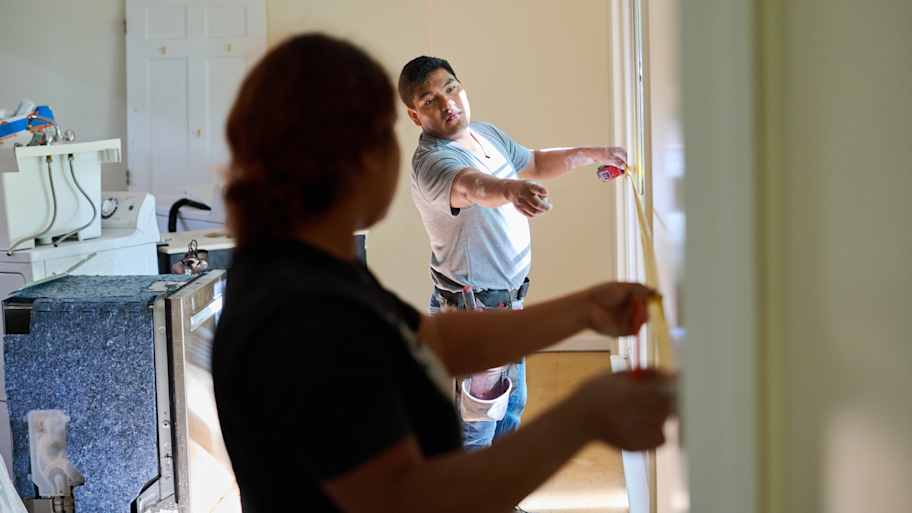8 of the Most Common Drywall Problems and How to Solve Them
Take the solution into your own hands


Drywall is one of the most common building materials, creating the base for walls, ceilings, and other structures in your home. So learning how to deal with drywall problems ASAP is essential, or you run the risk of even bigger issues piling up down the line. But if crumbling, cracking, and scuffed-up drywall has left you scratching your head, not to worry—we’ll teach you how to fix it up in a jiffy.
Note: When doing any drywall repairs, you should follow safety precautions like donning a protective mask and gloves.
1. Scuffs and Marks From Furniture
The Problem: Dining room chairs and rolling chairs in your office will inevitably come into contact with the drywall in your home. These unsightly dents and scratches will make the space feel neglected if you don’t keep on top of it.
The Solution: Minor drywall repair is something most homeowners can do themselves. First, remove any loose pieces of drywall from the problem area. Vacuum or dust out the spot, then apply an interior spackle (or joint compound) using a putty knife, which is an important drywall repair tool to have at your disposal. Let it dry before sanding it smooth.
Check to ensure that you have achieved a perfectly smooth surface. If not, reapply the spackle and sand again. Once that’s complete, spot prime with an interior primer and touch up with matching paint. If you can’t find a perfect match or the material has faded from age, paint the wall from end to end to ensure that everything blends together.
“With drywall repair, sanding is extremely important,” says Bob Tschudi, Angi Expert Review Board member and general contractor in Raleigh, NC. “You can’t take shortcuts here, as any imperfection will show up when you prime and paint the repair.”
2. Cracks in the Ceiling

The Problem: As your home settles over time, the seams that were covered up between the drywall of your ceiling will eventually shift around. You’ll most often see this problem in multi-story buildings because of the increased activity on the back of the ceiling, but it can also occur from things like storms, earthquakes, and other natural events.
The Solution: In order to repair a crack in a ceiling correctly, you’ll want to start by digging out the exposed line with a razor knife. Angle the blade and cut about one-quarter inch from each side, as this will provide a place to smear in drywall mud.
To keep the crack from occurring again, you’ll also need to install fiberglass drywall tape and smooth the surface in multiple stages. Let the mud dry before sanding, and apply multiple thin layers as you go to keep it super flat. A wide drywall knife and an expert hand are needed to repair drywall damage like this, so it’s highly recommended that you hire a local handyperson for ceiling drywall repairs. You can take steps to hire a drywall contractor if your repair requires specialized experience.
3. Water Damage
The Problem: The toilet leaked on the second floor or hail damage caused an unseen leak in the roof, and you now have an unsightly and discolored section of your ceiling. In this case, you’ll need to remove the damaged area and replace it with fresh drywall, as the material is permanently damaged once it has become soaked through with water.
The Solution: Using a razor knife or drywall saw, cut out the damaged section, preferably from between two joists so that you have a place to reattach the new drywall. Smooth down the edges with sandpaper and cut a new piece to match the hole. Reattach with drywall screws, then install drywall tape and mud in layers, let it dry, and then sand between coats until you’ve achieved a perfectly smooth surface.
“For water damage, you might have to use a stain-blocking primer,” Tschudi says. “Otherwise, the stain could bleed through the new coat of paint.”
4. Screws Too Deeply Embedded

The Problem: When you installed the drywall, you over-tightened the screw, it punched through the drywall, and it isn’t doing its job of holding the material to the wall anymore. Your drywall now looks bowed out and unprofessional.
The Solution: First, you’ll want to remove the screw that went in too far. If you leave it there, you’ll always have a problem with it showing through as a popped-out spot on the wall.
Once you’ve removed the screw, reattach a new screw in a different vertical location along the same wall joist. Install a new screw within 6 inches on each side of the old screw, while pressing down on the sheetrock to press it against the vertical joist. Patch and repair the holes with spackle, then prime and touch up with matching paint.
5. Hanging Joints
The Problem: Your home, while lovely and full of character, was built way back when and has presented a unique set of issues—specifically, the plaster ceilings have sagged over the years.
The Solution: If your ceiling is indeed plaster and you’re dealing with sagging ceilings, you will have a tough drywall problem to fix. Plaster chunks have likely slipped behind the material and created a barrier that will prevent them from being truly flat again. If this is the case, a local drywall contractor will be able to address the problem.
6. Picture Frame Holes

The Problem: Pictures and artwork lend your home plenty of character, but they also leave behind a tapestry of wall holes when one homeowner moves out, and another moves in.
The Solution: Painter’s putty is an easy fix for minor drywall repair, specifically smaller holes like those caused by picture mounts or tacks. This product is also called glazing putty and has a dough-like consistency.
You’ll want to make small balls of the putty before touching it into the hole, smoothing it with your finger, and then letting it dry. If you have the matching paint, take a paintbrush and dab it onto the hole for a couple of coats to make the hole disappear.
If you don’t have the paint or are repainting the room, priming is unnecessary, so you can simply paint as normal. This quick drywall fix is also great for repairing apartment walls.
7. Large Holes
The Problem: Sometimes, doors, elbows, or footballs inside the house (even though you forbade them) punch large, gaping holes into a drywall panel. Because there isn’t a surface behind it in which to attach a patch of sheetrock or fill it up with mud, so you’ve got an eyesore that’s difficult to repair.
The Solution: There are two ways to fix this common drywall problem. The old-school method is to place a paint stir stick behind the cavity and drill in drywall screws to cinch it back up against the hole. It takes a bit of practice, but this is a suitable solution if the hole is extra large. Once you’ve laid a piece of wood across the opening, there is now a surface on which to screw a fresh piece of drywall that’s cut to fit. Finally, use spackle or drywall mud as usual to smooth the surface.
A newer method involves a thin aluminum sheet with sticky fiberglass drywall tape along the sides. You’ll find them in the painting section of most hardware stores. Peel off the sticker backing, install the panel across the hole and then float the whole thing with drywall mud. Sand, prime, and finish with matching paint.
And if all else fails, call a drywall contractor to help. Hiring a pro to fix your drywall typically costs between $50 and $75 per square foot.
8. Patches on Textured Drywall
The Problem: You live in a home that has a texture applied to every surface of the drywall. This is a common drywall hack frequently utilized by contractors to quicken the pace of the finished work of installation. It also looks really slick and adds visual interest to a wall if it's done right. An issue arises if you need to match that texture because you’ve repaired the sheetrock.
The Solution: Once you’ve made the repair and covered up the hole or crack that you need to fix, you’ll need to go back over it with an artist’s touch. Hardware stores sell small cans of spray-on texture material that are a quick fix and fairly easy to use.
Cover the floor with tarps and tape off the baseboard before you start to spray to assist with cleanup. The pros will shave down the stipple that’s created by the sprayed-on texture with a wide putty knife to match the existing look. Prime and paint with matching paint once you’re happy with the texture.





- How to Repair Water-Damaged Drywall
- How to Patch a Hole in Drywall (From Small to Large)
- 11 Must-Know DIY Drywall Repair Tips
- Tools for Drywall: A Complete List for DIYers
- When Should You Hire a Pro for Drywall Repair vs. DIY?
- Who Should You Call For Drywall Repairs?
- Who Installs Drywall? Get the Right Pro for the Job
- How to Cut Drywall Before and After Hanging It
- How to Dispose of Drywall When You’re Done With a DIY
- How to Sand Drywall and Drywall Mud Successfully
















